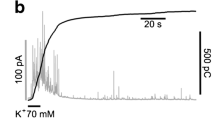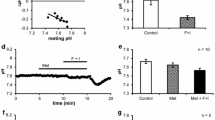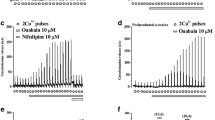Abstract
Regulation of intracellular free calcium ([Ca2+]i) in single epithelial duct cells of isolated rat and guinea pig pancreatic interlobular ducts by secretin, carbachol and cholecystokinin was studied by microspectrofluorometry using the Ca2+-sensitive, fluorescent probe Fura-2. Rat and guinea pig duct cells exhibited mean resting [Ca2+]i of 84 nM and 61 nM, respectively, which increased by 50%–100% in response to carbachol stimulation, thus demonstrating the presence of physiologically responsive cholinergic receptors in pancreatic ducts of both species. The carbachol-induced increase in [Ca2+]i involved both mobilization of Ca2+ from intracellular stores and stimulation of influx of extracellular Ca2+. In contrast, neither cholecystokinin nor secretin showed reproducible or sizeable increses in [Ca2+]i. Both rat and guinea pig duct cells showed considerable resting Ca2+ permeability. Lowering or raising the extracellular [Ca2+]i led, respectively, to a decrease or increase in the resting [Ca2+]i. Application of Mn2+ resulted in a quenching of the fluorescence signal indicating its entry into the cell. The resting Ca2+ and Mn2+ permeability could be blocked by La3+ suggesting that it is mediated by a Ca2+ channel.
Similar content being viewed by others
References
Argent BE, Arkle S, Cullen MJ, Green R (1986) Morphological, biochemical and secretory studies on rat pancreatic ducts maintained in tissue culture. J Exp Physiol 71:633–648
Arkle S, Lee CM, Cullen MJ Argent BE (1986) Isolation of ducts from the pancreas of copper-deficient rats. J Exp Physiol 71:249–265
Berridge MJ, Irvine RF (1984) Inositol trisphosphate, a novel second messenger in cellular signal transduction. Nature 312:315–321
Blair EL, Brown JC, Harper AA, Scratcherd T (1966) A gastric phase of pancreatic secretion. J Physiol (Lond) 184:812–824
Brown JC, Harper AA, Scratcherd T (1967) Potentiation of secretin stimulation of the pancreas. J Physiol (Lond) 190:519–530
Bundgaard M, Moller M, Poulsen JH (1981) Localisation of sodium pump sites in cat pancreas. J Physiol (Lond) 313:404–414
Cargill JM, Wormsley KG (1979) Effect of gastric distension on human pancreatic secretion. Acta Hepato-Gastroenterol 26:235–238
Case RM, Argent BE (1986) Bicarbonate secretion by pancreatic duct cells: Mechanisms and control. In: Go VLW et al. (eds) The exocrine pancreas: biology, pathobiology and diseases. Raven Press, New York, pp 213–243
Case RM, Scratcherd T (1972) The actions of dibutyryl cyclic adenosine 3′,5′-monophosphate and methyl xanthines on pancreatic exocrine secretion. J Physiol (Lond) 223:649–667
Debas HI, Yamagishi T (1978) Evidence for pyloropancreatic reflex for pancreatic exocrine secretion. Am J Physiol 234:E468-E471
Folsch UR, Creutzfeldt W (1977) Pancreatic duct cells in rats: secretory studies in response to secretin, cholecystokinin-pancreozymin, and gastrin. Gastroenterology 73:1053–1059
Folsch UR, Fischer H, Soling HD, Creutzfeldt W (1980) Effects of gastrointestinal hormones and carbamylcholine on cAMP accumulation in isolated pancreatic duct fragments from the rat. Digestion 20:277–292
Frizzell RA, Halm DR, Rechkemmer G, Shoemaker RL (1986) Chloride channel regulation in secretory epithelia. Fed Proc 45:2727–2731
Gray MA, Greenwell JR, Argent BE (1988) Secretin-regulated chloride channel on the apical plasma membrane of pancreatic duct cells. J Membr Biol 105:131–142
Gray MA, Harris A, Coleman L, Greenwell JR, Argent BE (1989) Two types of chloride channel on duct cells cultured from human fetal pancreas. Am J Physiol 257:C240-C251
Grinstein S, Rothstein A (1986) Mechanisms of regulation of the Na+/H+ exchanger. J Membr Biol 90:1–12
Grynkiewicz G, Poenie M, Tsien RY (1985) A new generation of Ca2+ indicators with greatly improved fluorescence properties. J Biol Chem 260:3440–3450
Guzman S, Chayvialle JA, Banks WA, Rayford PL, Thompson JC (1979) Effect of vagal stimulation on pancreatic secretion and on blood levels of gastrin, cholecystokinin, secretin, vasoactive intestinal peptide, and somatostatin. Surgery 86:329–336
Henriksen FW, Worning H (1967) The interaction of secretin and pancreozymin on the external pancreatic secretion in dogs. Acta Physiol Scand 70:241–249
Hootman SR, Logsdon CD (1988) Isolation and monolayer culture of guinea pig pancreatic duct epithelial cells. In Vitro Cell Dev Biol 24:566–574
Hootman SR, Williams JA (1987) Stimulus-secretion coupling in the pancreatic acinus. In: Johnson LR (ed) Physiology of the gastrointestinal tract, 2nd edn. Raven Press, New York, pp 1129–1146
Merritt JE, Hallam TJ (1988) Platelets and parotid acinar cells have different mechanism for agonist-stimulated divalent cation entry. J Biol Chem 263:6161–6164
Merritt JE, Jacob R, Hallam TJ (1989) Use of manganese to discriminate between calcium influx and mobilization from internal stores in stimulated human neutrophils. J Biol Chem 264:1522–1527
Negulescu PA, Machen TE (1988) Intracellular Ca regulation during secretagogue stimulation of the parietal cell. Am J Physiol 254:C130-C140
Novak I, Greger R (1988a) Electrophysiological study of transport systems in isolated perfused pancreatic ducts: properties of the basolateral membrane. Pflügers Arch 411:58–68
Novak I, Greger R (1988b) Properties of the luminal membrane of isolated perfused rat pancreatic ducts. Effects of cyclic AMP and blockers of chloride transport. Pflügers Arch 411:546–553
Padfield PJ, Garner A, Case RM (1989) Patterns of pancreatic secretion in the anaesthetised guinea pig following stimulation with secretin, cholecystokinin octapeptide, or bombesin. Pancreas 4:204–209
Schulz I (1987) Electrolyte and fluid secretion in the exocrine pancreas. In: Johnson LR (ed) Physiology of the gastrointestinal tract, 2nd edn. Raven Press, New York pp 1147–1171
Stuenkel EL, Machen TE, Williams JA (1988) pH regulatory mechanisms in rat pancreatic ductal cells. Am J Physiol 254:G925-G930
Stuenkel EL, Tsunoda Y, Williams JA (1989) Secretagogue induced calcium mobilization in single pancreatic acinar cells. Biochem Biophys Res Commun 158:863–869
Wormsley KG (1969) A comparison of the response to secretin, pancreozymin and a combination of these hormones in man. Scand J Gastroenterol 4:413–417
Author information
Authors and Affiliations
Rights and permissions
About this article
Cite this article
Stuenkel, E.L., Hootman, S.R. Secretagogue effects on intracellular calcium in pancreatic duct cells. Pflügers Arch 416, 652–658 (1990). https://doi.org/10.1007/BF00370610
Received:
Revised:
Accepted:
Issue Date:
DOI: https://doi.org/10.1007/BF00370610




